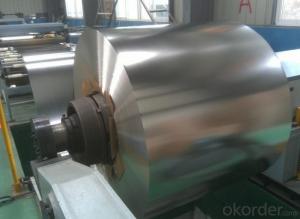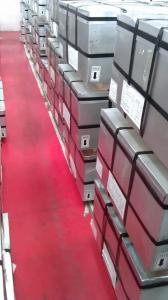Printing Tinplate Coils With Prime Quality for 0.20mm
- Loading Port:
- China main port
- Payment Terms:
- TT OR LC
- Min Order Qty:
- 25 m.t.
- Supply Capability:
- 1000 m.t./month
OKorder Service Pledge
OKorder Financial Service
You Might Also Like
Printing Tinplate Coils With Prime Quality for 0.20mm
1.Structure of Description
Printing Tinplate Coils With Prime Quality for 0.20mm is one of the metal packing materials, which is widely used for making painting cans ,chemical package cans , electrical cable ,battery and metal printing etc.
2. Main Features
Steady and high quality
Fast shipment
Good experience for export work
For the surface, Plate uniform in thickness,uniform and smooth tin coating, without flaws,rusts,scratch,wave,nick of tin coating etc.
Price competitive
3. Images

4. Specification
Standard : GB2520-2000 ,JIS G3303
Steel type : SPCC
Coating : 2.8/2.8
Surface: Bright, Stone ,
Thickness:0.31
Width :600MM~1000MM
Temper : T1~T5
Package: tinplate wrapped completely with an inner cover of plastic or waterproof papers with vorners protected with metal angels.
5.FAQ
A. What is the package of tinplate? (Referred as below)
For sheets, thin plastic film + rust-proof paper + metallic cover + metallic angles+ steel band strips + fumigated wooden pallet.
For coil, thin plastic film + rust proof paper + metallic cover + steel band strips + fumigated wooden pallet
B. The surface of tinplate could you supply?
Stone finish, Bright finish, Matte finish, Silver finish
C. What quantity is the minimum order of tinplate?
Usually, the minimum quantity is 25MT. For special case, consult with us.
D. Can it make to be BA or CA for annealing?
Yes, both can do with.
- Q: How does tinplate contribute to the containment of chemical substances?
- Tinplate contributes to the containment of chemical substances through its excellent barrier properties. The tin coating on the steel substrate forms a protective layer that prevents direct contact between the chemical substances and the metal, reducing the risk of corrosion and contamination. This barrier also helps to maintain the integrity and stability of the chemical substances by preventing interactions with external factors such as moisture, oxygen, and light. Overall, tinplate provides a secure and durable packaging solution for chemical substances, ensuring their safety and quality throughout storage and transportation.
- Q: How is tinplate affected by exposure to oxygen?
- Tinplate is generally not affected by exposure to oxygen, as it forms a protective layer of tin oxide on its surface that prevents further oxidation.
- Q: Can tinplate be used for pet food packaging?
- Yes, tinplate can be used for pet food packaging. Tinplate is a commonly used material for packaging due to its durability, corrosion resistance, and ability to maintain product freshness. It is often chosen for pet food packaging as it provides a protective barrier against moisture, oxygen, and light, ensuring the quality and safety of the food.
- Q: Can tinplate be printed on?
- Yes, tinplate can be printed on.
- Q: Soup with tin cans loaded also need high temperature sterilization?
- At present, there are DN400x500, DN600x1000, DN800*1000, DN900*1000 and DN900x1500 in the market, and the small sterilization pot with boilers is heated by steam. If not, heating by electricity can also be done. The phone won't be left. If you need any service from the manufacturer, you can call me from Hi. The key is not to sell, eliminating confusion is the key.
- Q: What is the global demand for tinplate?
- The global demand for tinplate is significant and steadily increasing. Tinplate is widely used in the packaging industry, particularly for food and beverage cans, due to its excellent corrosion resistance and ability to maintain product freshness. Additionally, the growing popularity of canned food, beverages, and other consumer goods across various regions has further fueled the demand for tinplate worldwide.
- Q: What are the main applications of tinplate in the energy industry?
- Tinplate finds various applications in the energy industry, primarily in the manufacturing of batteries and solar panels. It is commonly used as a protective coating for the metal components of batteries, preventing corrosion and extending their lifespan. Additionally, tinplate is used in the production of solar panels, where it acts as a reliable barrier against moisture and other environmental factors, ensuring the longevity and efficiency of the panels.
- Q: How is tinplate coated for gift packaging?
- Tinplate is typically coated for gift packaging through a process called electrolytic tinplating. This involves immersing the tinplate in an electrolyte solution and passing an electric current through it, causing a layer of tin to be deposited onto the surface of the tinplate. This tin coating provides a protective barrier against corrosion and enhances the overall appearance of the packaging, making it more suitable for gift presentation.
- Q: What are the main markets for tinplate?
- The main markets for tinplate are primarily the packaging industry, especially for food and beverages, as well as the manufacturing of cans, containers, and aerosol cans. Additionally, tinplate is used in various industries such as automotive, construction, electronics, and pharmaceuticals for its corrosion-resistant properties.
- Q: What are the transportation considerations for tinplate?
- Transportation considerations for tinplate include ensuring proper packaging and securing the tinplate to prevent damage during transit. Due to its susceptibility to corrosion, tinplate should be protected from moisture and extreme temperatures. Additionally, the weight and size of tinplate may impact the choice of transportation method and require careful handling to prevent accidents or injuries.
Send your message to us
Printing Tinplate Coils With Prime Quality for 0.20mm
- Loading Port:
- China main port
- Payment Terms:
- TT OR LC
- Min Order Qty:
- 25 m.t.
- Supply Capability:
- 1000 m.t./month
OKorder Service Pledge
OKorder Financial Service
Similar products
Hot products
Hot Searches
Related keywords




























